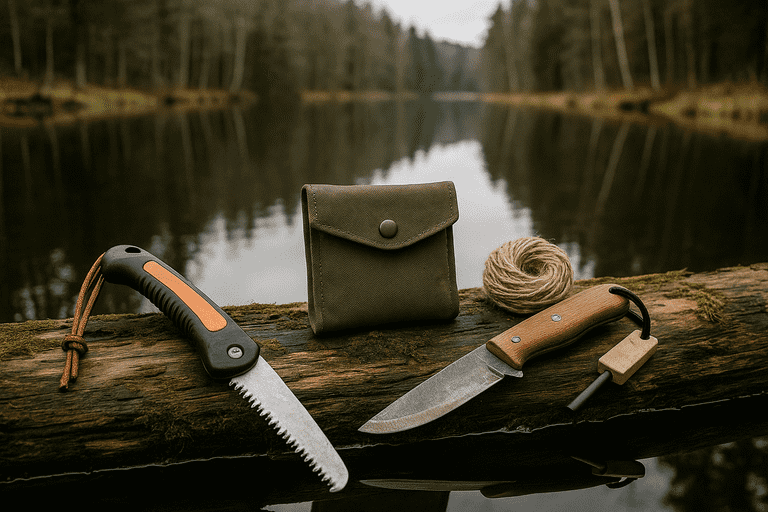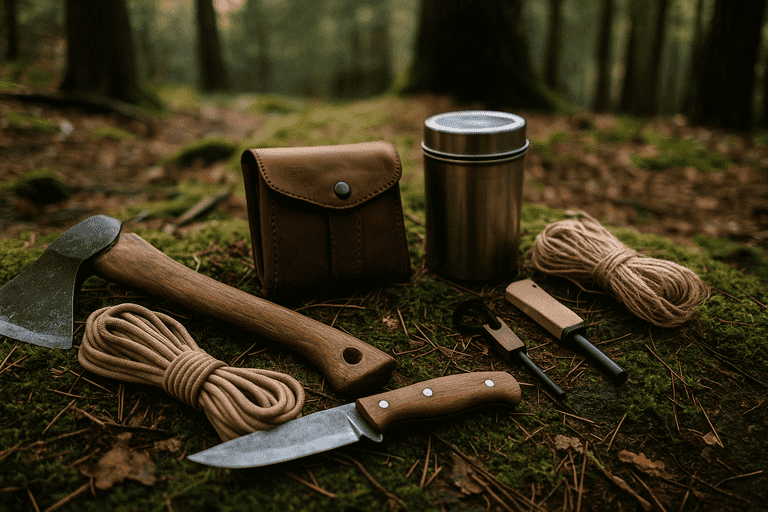In a world full of modern conveniences, there is something deeply empowering about self-reliance. A well-prepared bushcraft survival kit gives you that empowerment. For instance, it provides the tools necessary to build a shelter, make fire, purify water, and hunt or forage—all using your own hands and skills.
In addition, bushcraft is not about just surviving; it’s about thriving in the wild. When you carry the right gear and the right mindset, you gain the ability to adapt, endure, and stay calm no matter how far from civilization you find yourself. Therefore, assembling a solid bushcraft kit becomes more than preparation—it becomes a philosophy.
What to Include
A proper bushcraft survival kit begins with the basics, but it goes beyond them to include versatile, rugged tools. First, a reliable fixed-blade knife is non-negotiable. For instance, you can use it to process wood, clean fish, or carve tools. Fire starters such as a ferro rod, waterproof matches, or a magnesium block are also essential.
In addition, include a compact tarp or emergency blanket for shelter, and carry cordage like paracord or bank line. A metal container serves both for boiling water and cooking. Don’t forget a sharpening stone, signaling device, and small first-aid kit. Therefore, every item should serve multiple functions while remaining lightweight and durable.

Bushcraft Survival Kit for Different Environments
Not all landscapes present the same challenges. For instance, surviving in a snowy forest requires different tools than thriving in a desert. Therefore, tailor your bushcraft survival kit to the specific environment you plan to explore. In cold climates, add hand warmers, wool socks, and a folding saw for gathering firewood.
Bushcraft Classes: Rediscovering Nature Skills
In addition, desert environments may require extra water storage, sun protection, and lightweight clothing for temperature regulation. Swampy areas might call for mosquito netting, high-traction footwear, and anti-fungal supplies. Always research the local flora and fauna before heading out—preparation makes adaptation possible.
Building Skills
Owning a great bushcraft survival kit means little if you lack the skills to use it effectively. For instance, many people pack a ferro rod but don’t know how to strike a spark. Therefore, invest time in practicing the basics: knot-tying, fire-building, shelter construction, and knife handling.
In addition, you should regularly test your gear in real-world conditions. Go on short hikes or overnight trips where you rely only on what’s in your kit. That way, you’ll understand what works, what’s missing, and how to improve your setup. Bushcraft is built through experience, not equipment alone.

Common Mistakes When Assembling a Bushcraft Survival Kit
While enthusiasm is good, overpacking is a frequent mistake. A bushcraft survival kit should be compact and efficient—not a burden. For instance, many people carry multiple blades or tools with overlapping functions. Instead, choose high-quality, multipurpose gear.
Survival Backpack Kit: Essential Gear for Emergencies
In addition, avoid packing gear you don’t know how to use. Carrying a slingshot or snare wire is useless if you’ve never practiced with them. Therefore, your kit should reflect your skill level and real needs. Start simple, then expand as your confidence grows. More is not always better—smarter is.
Long-Term Sustainability
Unlike typical survival kits designed for short-term emergencies, a bushcraft survival kit supports long-term, sustainable living. For instance, rather than disposable items, bushcraft gear tends to be reusable, repairable, and built to last. This promotes a lifestyle that respects the environment and encourages minimal impact.
In addition, bushcraft techniques emphasize harvesting local resources without overexploitation. You learn to take only what you need, reuse materials, and leave nature as you found it. Therefore, bushcraft is not just survival—it’s stewardship. The kit you build is a symbol of your values, not just your skills.
Teaching Others With Your Bushcraft Survival Kit
Once you’ve mastered the use of your bushcraft survival kit, you have an opportunity to pass on that knowledge. For instance, teaching your children how to make fire safely or identify edible plants builds confidence and creates powerful shared experiences. In addition, it ensures future generations carry forward vital skills.
Why Cheap Survival Gear Can Still Save Your Life
Moreover, community bushcraft meetups, workshops, or online tutorials allow you to connect with others who share your passion. Therefore, your kit becomes more than a tool—it becomes part of your story and legacy. By sharing what you’ve learned, you multiply the value of your skills.

Maintaining and Updating Your Bushcraft Survival Kit
A kit is only useful if it works when you need it. Therefore, maintaining your bushcraft survival kit is essential. For instance, sharpen your knife regularly, keep ferro rods dry, and replace expired or damaged items. Inspect your gear seasonally, especially before extended trips.
In addition, adjust your kit as your knowledge and environment change. You may find new tools that suit your needs better, or discover that some items are rarely used. Bushcraft is a dynamic practice. As you evolve, so should your gear. Keep it lean, relevant, and always field-tested.
Bushcraft Survival Kit vs. Traditional Survival Kits
Although both serve similar purposes, a bushcraft survival kit differs significantly from a standard survival kit. For instance, most commercial survival kits focus on quick rescue and short-term emergencies—often including prepackaged rations, plastic ponchos, or single-use tools.
In contrast, bushcraft kits prioritize long-term sustainability, skill-based use, and multifunctional gear. In addition, they reflect a different mindset—where surviving is just the beginning. Therefore, choose a bushcraft setup if your goal is deep nature immersion, not just escape and rescue.
Integrating Your Bushcraft Survival Kit Into Everyday Preparedness
You don’t need to live in the woods full time to benefit from a bushcraft survival kit. For instance, many people keep a compact version in their car, backpack, or bug-out bag. Basic tools like a knife, lighter, water filter, and cordage can be useful in both urban and rural emergencies.
In addition, practicing your bushcraft skills regularly makes you more confident in everyday challenges. Whether it’s camping with friends, dealing with a blackout, or helping during a natural disaster, you’ll be better equipped—physically and mentally. Therefore, bushcraft isn’t about escaping modern life; it’s about enhancing it.

